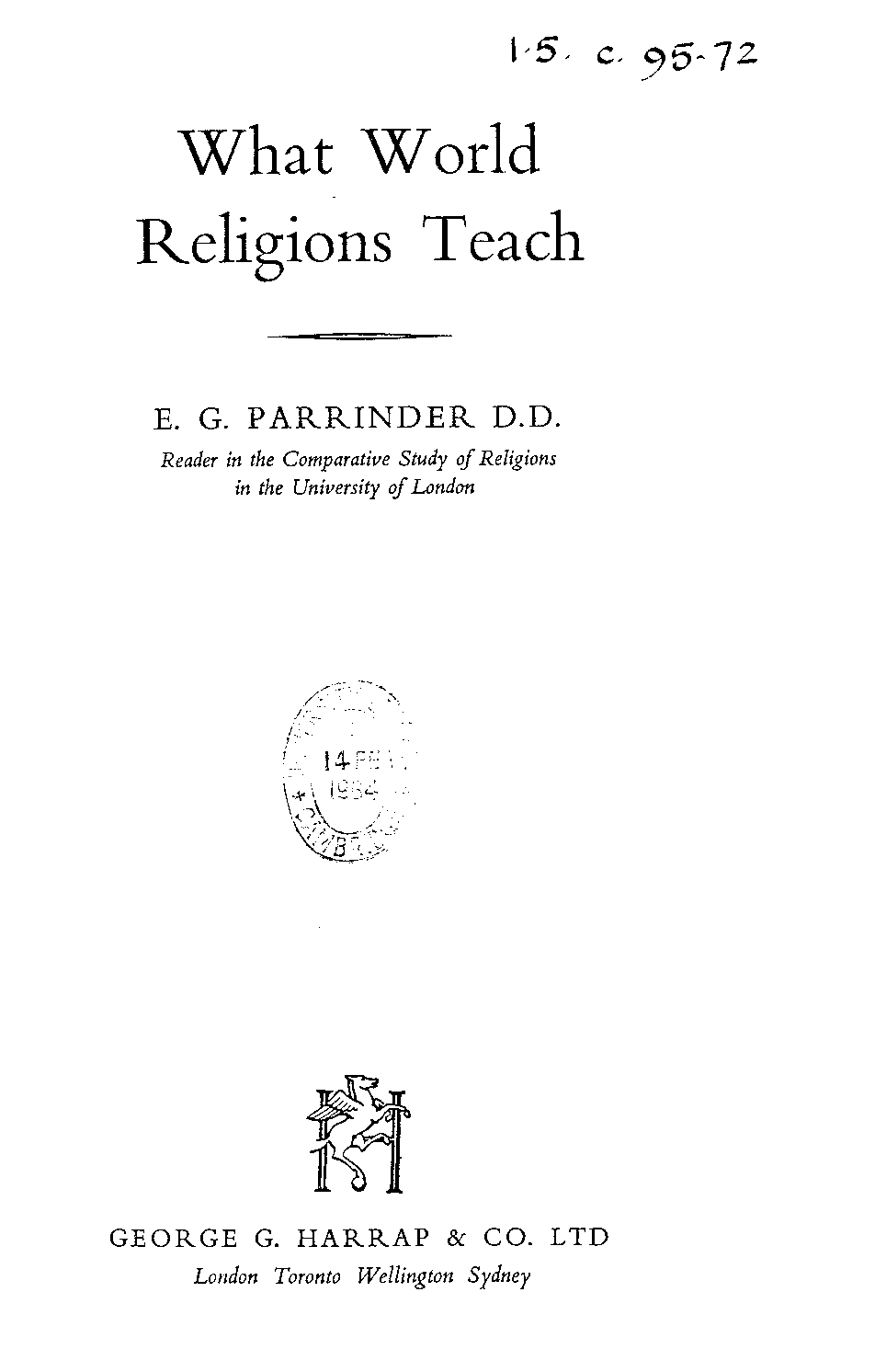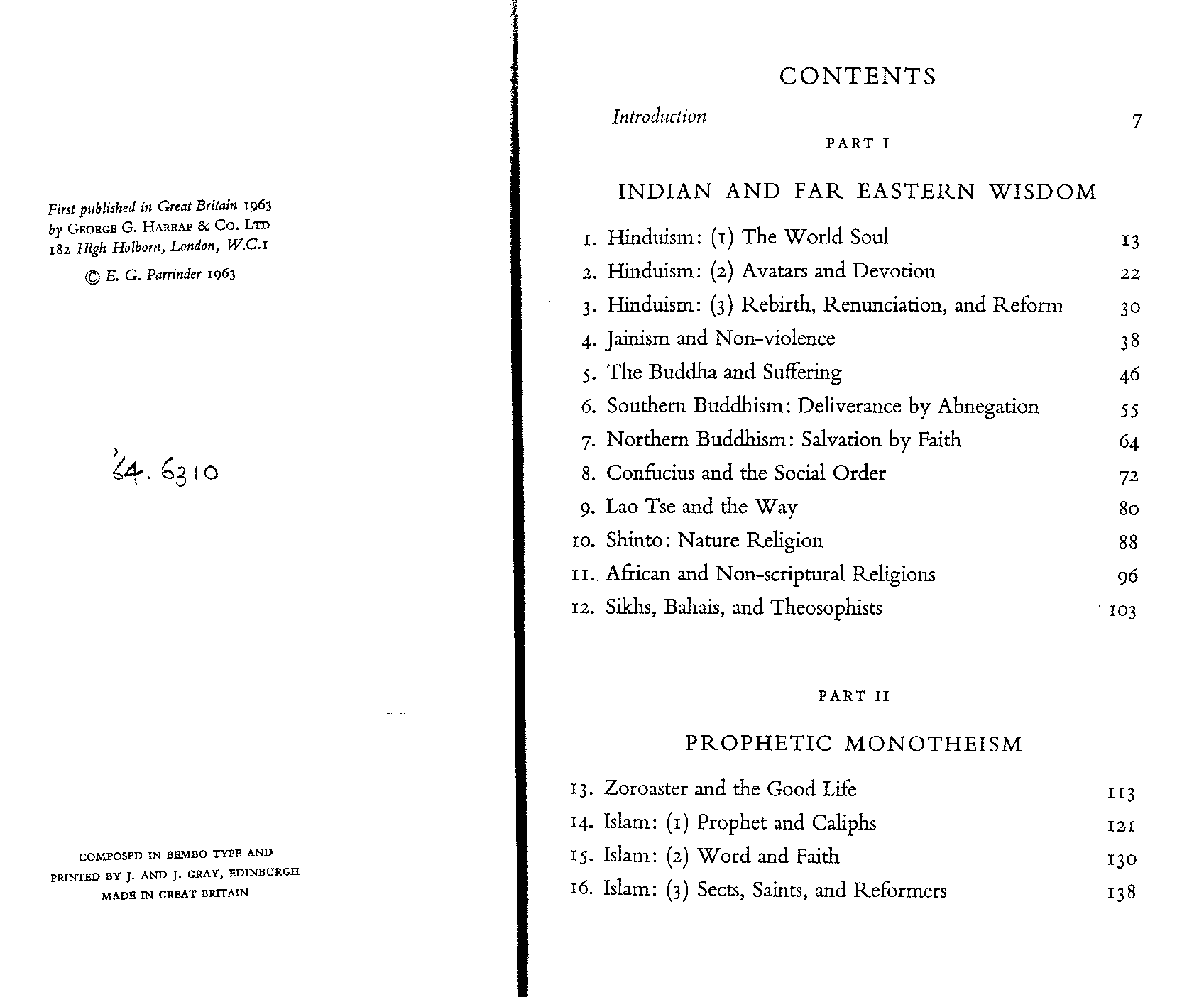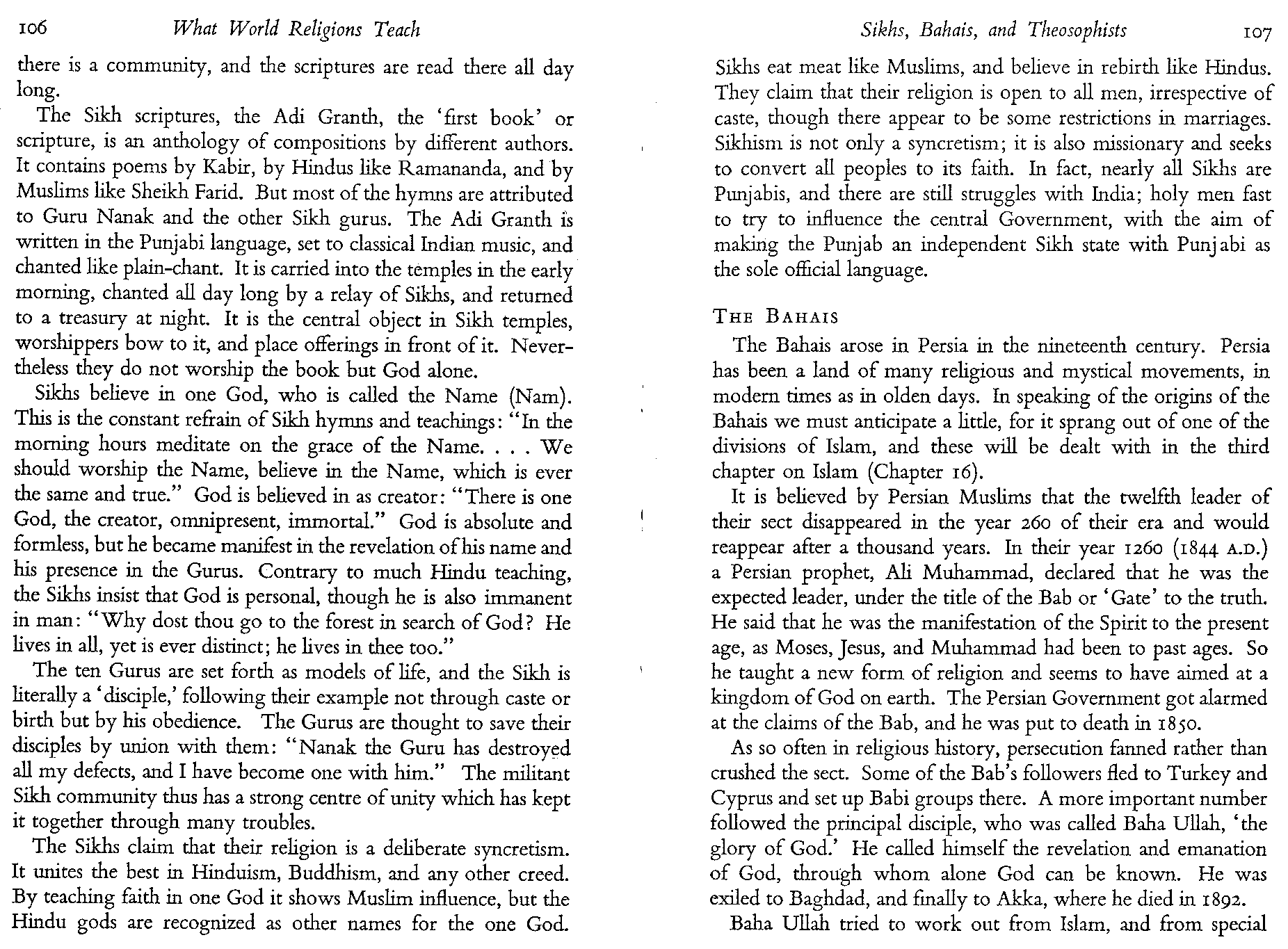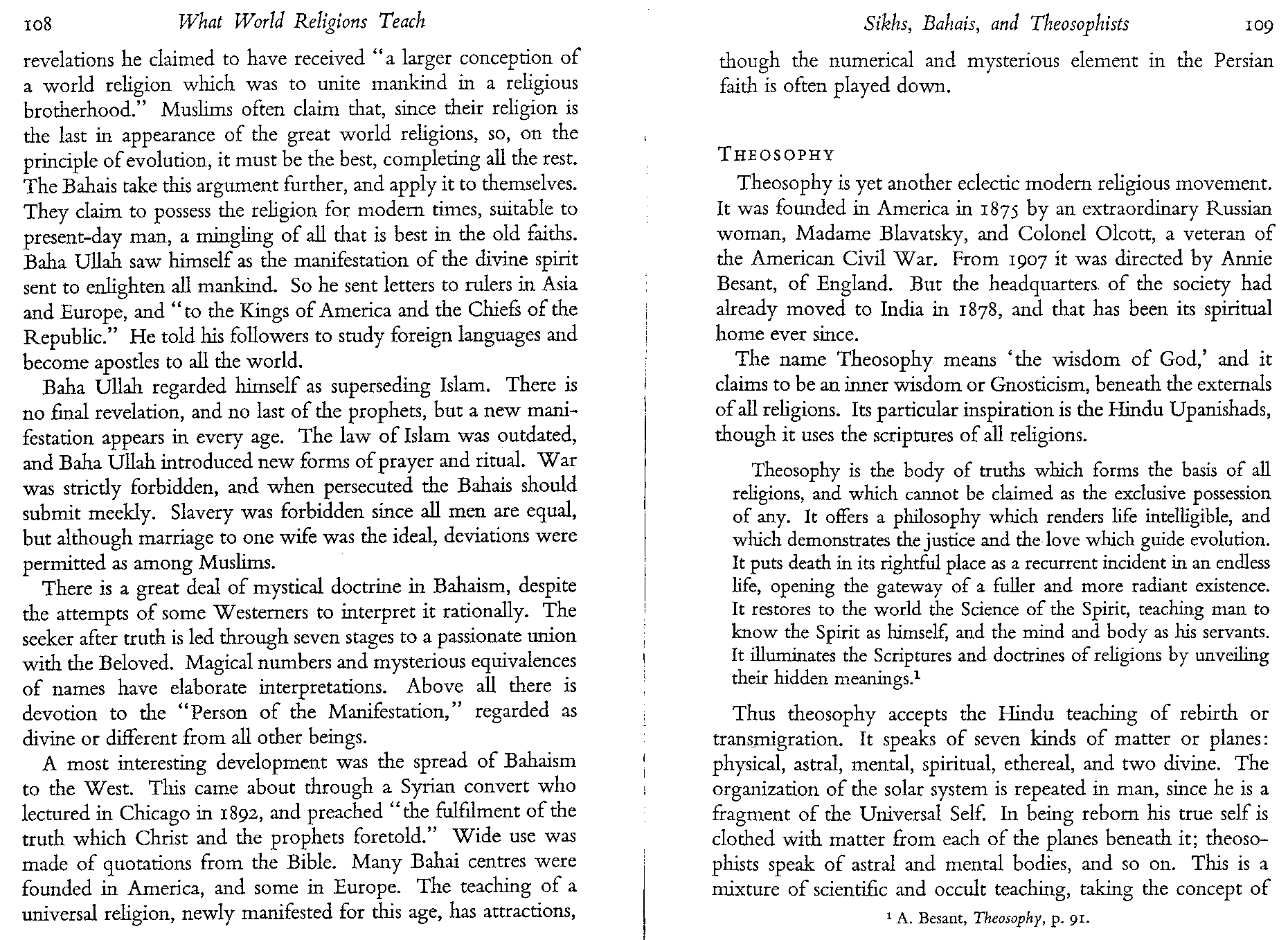
|
|
Abstract: Two-page excerpt from Chapter 12, "Sikhs, Bahais, and Theosophists," and two other passing mentions. |
The Bahá'ís
by Geoffrey Parrinder
published in What World Religions Teach, pages 107-109, 140, 190London: George W. Harrap & Co., 1963
1. Text
[page 107]
THE BAHAIS
The Bahais arose in Persia in the nineteenth century. Persia has been a land of many religious and mystical movements, in modem times as in olden days. In speaking of the origins of the Bahais we must anticipate a little, for it sprang out of one of the divisions of Islam, and these will be dealt with in the third chapter on Islam (Chapter 16).
It is believed by Persian Muslims that the twelfth leader of their sect disappeared in the year 260 of their era and would reappear after a thousand years. In their year 1260 (1844 A.D.) a Persian prophet, Ali Muhammad, declared that he was the expected leader, under the title of the Bah or 'Gate' to the truth. He said that he was the manifestation of the Spirit to the present age, as Moses, Jesus, and Muhammad had been to past ages. So he taught a new form of religion and seems to have aimed at a kingdom of God on earth. The Persian Government got alarmed at the claims of the Bah, and he was put to death in 1850. As so often in religious history, persecution fanned rather than crushed the sect. Some of the Bab's followers fled to Turkey and Cyprus and set up Babi groups there. A more important number followed the principal disciple, who was called Baha Ullah, 'the glory of God.' He called himself the revelation and emanation of God, through whom alone God can be known. He was exiled to Baghdad, and finally to Akka, where he died in 1892. Baha Ullah tried to work out from Islam, and from special
[page 108]
revelations he claimed to have received "a larger conception of a world religion which was to unite mankind in a religious brotherhood." Muslims often claim that, since their religion is the last in appearance of the great world religions, so, on the principle of evolution, it must be the best, completing all the rest. The Bahais take this argument further, and apply it to themselves. They claim to possess the religion for modem times, suitable to present-day man, a mingling of all that is best in the old faiths. Baha Ullah saw himself as the manifestation of the divine spirit sent to enlighten all mankind. So he sent letters to rulers in Asia and Europe, and "to the Kings of America and the Chiefs of the Republic." He told his followers to study foreign languages and become apostles to all the world.
Baha Ullah regarded himself as superseding Islam. There is no final revelation, and no last of the prophets, but a new manifestation appears in every age. The law of Islam was outdated, and Baha Ullah introduced new forms of prayer and ritual. War was strictly forbidden, and when persecuted the Bahais should submit meekly. Slavery was forbidden since all men are equal, but although marriage to one wife was the ideal, deviations were permitted as among Muslims.
There is a great deal of mystical doctrine in Bahaism, despite the attempts of some Westerners to interpret it rationally. The seeker after truth is led through seven stages to a passionate union with the Beloved. Magical numbers and mysterious equivalences of names have elaborate interpretations. Above all there is devotion to the "Person of the Manifestation," regarded as divine or different from all other beings.
A most interesting development was the spread of Bahaism to the West. This came about through a Syrian convert who lectured in Chicago in 1892, and preached "the fulfilment of the truth which Christ and the prophets foretold." Wide use was made of quotations from the Bible. Many Bahai centres were founded in America, and some in Europe. The teaching of a universal religion, newly manifested for this age, has attractions,
[page 109]
though the numerical and mysterious element in the Persian faith is often played down.
...
[page 140]
...
Quite different was the Ahmadiyya movement in India, though it gave an Indian version of the Mahdi hope. In 1890 Ghulam Ahmad, of the Punjab, claimed to be both the Mahdi of Islam and the Messiah of Christianity, and later is said to have claimed also to be an incarnation of the Hindu Krishna, his coming having been foretold in all scriptures. After his death his followers divided into two main groups, one centred round his tomb at Qadian in India, the other at Lahore in Pakistan. Ghulam Ahmad is regarded as the latest renewer of religion, for every age has its revelation and renewer (an idea that we noted in connexion with the Bahais). But religion is a matter of the spirit, nothing to do with politics or holy wars. So great stress was laid on peaceful propaganda, and Ahmadiyya missionaries have gone to many parts of the world. The mosque at Woking, perhaps the best known in England, belongs to the Ahmadiyya, and much literature on the teachings of Islam comes from them. Nevertheless they are not regarded as orthodox Muslims, and some of their teachings are repudiated by the orthodox. For example, the Ahmadiyya say that Jesus escaped death in Palestine and wandered away to India, where his grave is to be seen at Shrinagar - a legend that both Muslims and Christians reject.
[page 190]
...
Christianity is a missionary religion, and there are those who object to or misunderstand missions. It is not the only missionary religion. Islam and Buddhism always have been, and in modem times the Sikhs, Bahais, Theosophists, and Ramakrishna Mission all seek to convert other people to their point of view.
...
2. Image scans (click image for full-size version)

|
|





